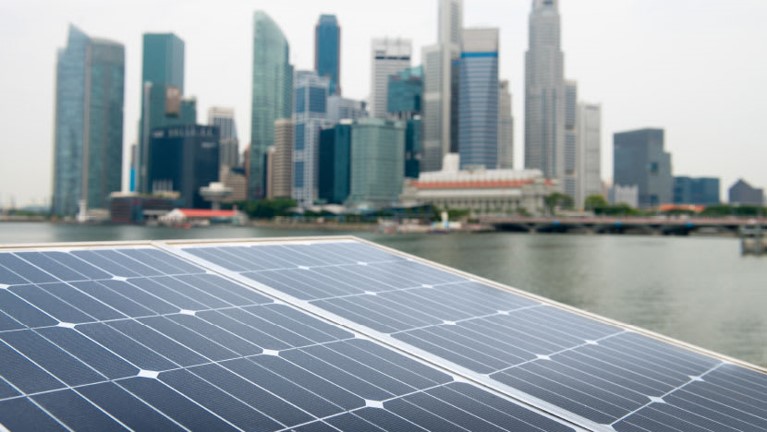Singapore aims to better manage electricity supply with enhanced energy management system
First published online at CNA

SINGAPORE: As Singapore charges towards its 2030 goals for sustainable development, unpredictable weather like rain and cloud cover could dampen the nation’s solar energy aspirations.
But the Energy Market Authority (EMA) appears to have found a way to overcome inconsistent sunlight to ensure a more consistent power supply.
The statutory board is touting an enhanced system that can predict solar power across Singapore – up to an hour in advance – with one of the best accuracy rates in the tropics.
Its new solar forecasting model has an error rate of less than 10 per cent, allowing the agency to better anticipate solar power generation that can vary in different weather conditions.
This enables EMA to manage electricity supply and demand more efficiently, the authority said in a statement on Tuesday (Jun 12).
The model is part of an enhanced energy management system, or EMS II, for the country's electricity network.
This system can automatically tap into stored energy and is better able to address power disruptions and cyber threats.
“This new EMS upgrade allows us to future-proof our grid infrastructure to enhance the reliability of the power system. It also helps us to meet our net-zero goal in 2050,” said the authority’s director of energy management systems Lim Wee Seng.
More reliable solar power means less reliance on natural gas to power the country, bringing Singapore closer to its emissions targets.
HOW DOES SOLAR PREDICTION WORK?
The conversion of sunlight into electrical energy through solar technologies is always going to be inconsistent due to sporadic weather changes.
Even in tiny Singapore, sunlight levels are not the same in different locations. It could be sunny in one neighbourhood, while the next district just a few bus stops away could be experiencing spotty showers or be overcast with clouds.
The traditional energy management system could only estimate solar energy in real time by using data sourced across Singapore.
The new system uses sensors, satellite imagery and machine learning to allow EMA to go beyond real-time estimates to forecast solar output an hour ahead at greater accuracy than ever before.
When it is sunny, the system taps solar energy to power homes, offices and transport networks. The storage system can also automatically store surplus energy for later.
When the weather is less optimal or when electricity demand is high, the system can draw from stored power to meet those energy needs.
This lets the EMA quickly manage changes in demand and supply, to ensure a stable electricity supply for the nation.
ELECTRICITY DEMAND TO INCREASE
The EMA said the nation’s electricity demand is expected to grow as industries seek to reduce carbon emissions by switching from fossil fuels to electricity.
Electricity-intensive sectors such as advanced manufacturing and the digital economy are also set to expand.
The agency expects system peak demand to increase at a compound annual growth rate of up to 5 per cent over the next five years.
With a need to tap on new energy sources such as solar and regional electricity imports, the agency said the system will allow it to manage the new sources more effectively.
EMS II also incorporates advanced cybersecurity features that protect the system against malicious cyber threats, including a tool that monitors and collects data from devices within the network.
Professor Xu Yan, Nanyang Technological University’s (NTU) director of the Center for Power Engineering, said the enhanced system could help expand solar adoption in Singapore.
“With solar forecasting, we can handle solar intermittency more effectively. Hence, we can host more solar power in the grid … making it much easier to scale up solar adoption,” he explained.
SINGAPORE’S SOLAR AMBITIONS
By 2030, Singapore wants to ramp up its solar energy deployment to at least two gigawatt-peak (GWp) – enough to meet annual power needs of around 350,000 households, or 3 per cent of the nation’s projected total electricity demand.
Prof Xu said he is optimistic that Singapore is on track to meet this goal, but stressed that regular maintenance of solar panels remains key to operating at a high efficiency.
This is because dirty or damaged panels will generate less energy and could affect the system’s forecasting accuracy.
“We have already made a lot of good progress towards solar power placement in the grid, so I'm quite optimistic on that goal to be achieved, especially with this enhanced EMS,” he told CNA’s Singapore Tonight programme.
He said an increase in solar adoption could – at some point – bring electricity prices down for consumers, but only if such energy generation is consistent, and after factoring in the initial costs of setting up photovoltaic and storage technologies.
“The price of electricity primarily depends on the cost of power generation. So, if we can use cheaper power sources such as solar which does not consume any fuel – theoretically, yes, the electricity price (could) become lower,” Prof Xu said.














/enri-thumbnails/careeropportunities1f0caf1c-a12d-479c-be7c-3c04e085c617.tmb-mega-menu.jpg?Culture=en&sfvrsn=d7261e3b_1)

/cradle-thumbnails/research-capabilities1516d0ba63aa44f0b4ee77a8c05263b2.tmb-mega-menu.jpg?Culture=en&sfvrsn=1bc94f8_1)






